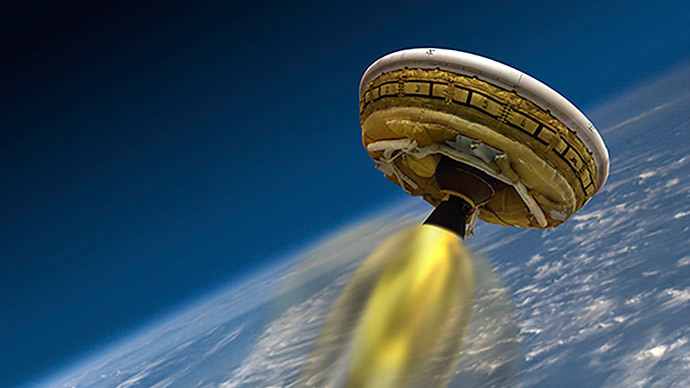NASA's Mars landing system fails for a second time

NASA's test run of a Mars landing system came to a quick end on Monday when the saucer-shaped vehicle's parachute failed to open high over the Pacific Ocean, a NASA TV broadcast showed.
The system, called the Low-Density Sonic Decelerator (LDSD) was elevated high into the atmosphere over the remote Hawaiian island of Niihau by a balloon, which, at its maximum size, is as large as a football stadium, making it the largest inflatable ever tested. The aim of the design is to safely deliver a heavy manned spacecraft to Mars.
The balloon carrying #LDSD can fill the Rose Bowl Stadium. That's a big balloon! #321techoff#journeytomarspic.twitter.com/Xlope0xeOu
— NASA Technology (@NASA_Technology) June 8, 2015
The vehicle was launched from the Hawaiian island of Kauai and made its way west, over the uninhabited island of Niihau.
Once it reached 120,000 feet (36.5km) – over three times the maximum altitude of a passenger jet – the vehicle detached from the balloon and activated its Star 48 solid-fueled rocket engine, taking it to 180,000 feet (54km) at four times the speed of sound, which brought on an uproar of cheering from the NASA staff.
The broadcast was streamed live with visuals and commentary straight from the NASA team.
At this dizzying height the descent began, and the donut-like Supersonic Inflatable Aerodynamic Decelerator (SIAD) inflated with pressurized gas, which helped to slow the fall. “It pops like the airbag in your car, but shaped like a donut,” said NASA spokesman Joshua Buck.
Phase two of the descent was supposed to involve a 100 foot (30 meters) diameter parachute opening and slowing it down even further. However, the parachute only opened partially in what was called a “partial chute” by the NASA commentators.
Reaching Mach 4, #LDSD's SIAD deployed & inflated. Chute deployed, but did not inflate. We'll study data from this test to learn & improve.
— NASA Technology (@NASA_Technology) June 8, 2015
A similar problem affected the LDSD debut run last year. The parachute was redesigned and reinforced for the second flight, but more work will be needed before the system is ready to land heavy loads, be it on Earth or on Mars.
The ‘black box’ containing recorded sensor information was retrieved afterwards. The information will be invaluable for the improvement of the landing system according to the NASA commentators.












